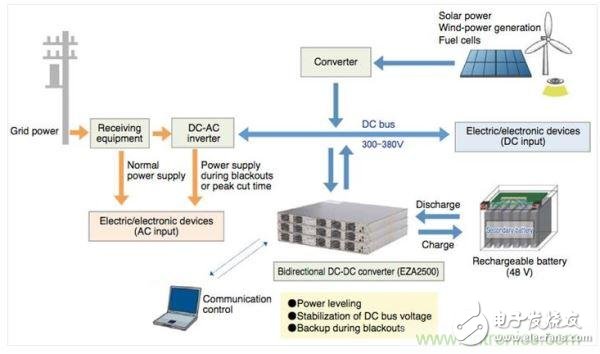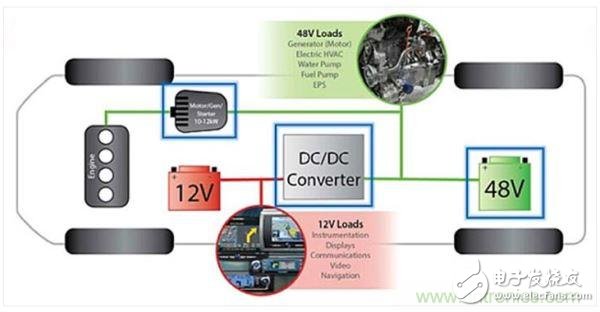[Introduction] With our development, we expect more applications such as bidirectional DC/DC converter architecture to be available in 2017. We even saw a full SiC DC/DC bidirectional DC/DC converter. GaN is also a power component that can be used in these systems, so we are also expected to see more designs that use this technology.
Bidirectional DC/DC converters have been around for a while, but new applications are emerging rapidly, and they need to use this architecture in more systems. Today's applications require higher power efficiency and such systems because solar or wind power needs to store electrical energy so that power is not interrupted in the absence of wind or the sun.

Figure 1: A bidirectional DC/DC converter can be used in an energy storage system.
The battery backup system requires a bidirectional DC/DC converter because the battery is charged when the power is available, but in the event of a power outage, the battery will be the backup power source. Vicor offers a great solution for this area with its new bidirectional DC/DC topology.

Figure 2: Vicor's new isolated bidirectional DC/DC converter topology
Vicor built a prototype with 300W input for battery charging and 1500W output for supporting bus loads. The prototype can be designed with higher power by using parallel technology and some reconfiguration. Vicor has a new "A New High Efficiency Isolated Bi-Direc TIonal DC-DC Converter for DC-Bus and Battery-Bank Interface" Excellent article, written by Xiaoyan Yu and Paul Yeaman.
In the automotive sector, we must now consider the use of high-voltage power architectures to manage batteries in electric vehicles/hybrid vehicles (EV/HEV). Hybrid cars have a regenerative braking function that stores this energy to provide the extra energy needed during acceleration. The EV/HEV dual voltage system has 12V and 48V batteries and requires bidirectional DC/DC conversion.

Figure 3: A 48V to 12V bidirectional DC/DC converter
Intersil developed the first 6-phase bidirectional DC/DC controller ISL78226. The device delivers up to 3.75 kW of power with efficiencies as high as 95% or more.
Figure 4 is a car with a 48V mild hybrid system. It has undergone some changes on the standard non-hybrid system - a 48V battery has been added, and a 12V starter alternator has been replaced by a 48V starter generator. Finally, it adds a DC/DC converter for bridging the 48V bus and the 12V bus. Thus, the power generated by the 48V starter generator is used to charge the 12V battery and power all unaltered 12V electronics. The ISL78226 is the heart of the DC/DC converter.

Figure 4: 12V and 48V board network on a 48V mild hybrid.
Therefore, as we grow, we expect more applications in this bi-directional DC/DC converter architecture to be available in 2017. We even saw a full SiC DC/DC bidirectional DC/DC converter. GaN is also a power component that can be used in these systems, so we are also expected to see more designs that use this technology.
Extended reading:
Wireless power: Wireless power will be advanced in 2017. Wurth Elektronik is working with ROHM Semiconductor to enable designers to accelerate time-to-market with wireless power design kits in addition to their wireless power reference designs. EPC Power Conversion (EPC) has some very good eGaN power component solutions for wireless power supplies, with some excellent application notes and evaluation boards that are very user friendly. The Wireless Power Consortium (WPC) is bringing Qi standard solutions and momentum to market. In 2015, the Wireless Power Alliance (A4WP) and the Power Affairs Alliance (PMA) merged. At the Wireless Power Summit in November 2016, companies such as Dell, Hewlett-Packard, Disney, Haier and ZPower attended, which indicates that some progress will be made in 2017. Apple has not yet launched an integrated wireless charging solution, but there are talks that Apple will enable wireless charging on its latest iPhone case. In addition, there are already many wireless charging cases developed by the third-party developers for the iPhone 7 on the market. At the CES show in 2017, you will see more research and development in this area.
Wearable Electronics Power: The Internet of Things (IoT) will grow rapidly in 2017, especially in the field of wearables for fitness and medical applications. Some of the most demanding problems may require the battery to operate longer to charge, and the power bias noise generated by the switching regulator may interfere with the spread spectrum communication device and the navigation and positioning equipment. Companies like TransSiP have used these solutions for switching noise jitter (SNJ) to regulate JC-PFM technology to address these challenges. Linear Technology also offers some new solutions for wearable power supplies. Their LTC3388-1 is an ultra-low quiescent current-synchronous buck converter that addresses the low-power requirements with the LTC3335, a nano-scale high efficiency synchronous buck-boost converter with an on-board precision coulomb counter. The LTC3331 is an energy harvesting solution IC that provides a new way to power smart wearable devices. Undoubtedly, more innovations will come in 2017.
Super High Voltage Film Capacitor
Polyester Film Capacitor,DC Filter Capacitor,precision capacitor
XIAN STATE IMPORT & EXPORT CORP. , https://www.capacitorhv.com